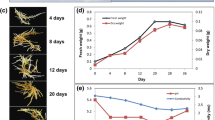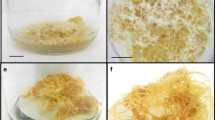Abstract
The extent of rooting in cuttings of Phaseolus vulgaris L., and Vigna radiata Wilcz. was affected by 4-chlororesorcinol, a polyphenol oxidase inhibitor. More root primordia and more roots were formed after 4-chlororesorcinol treatment both with and without 10-5M Indole butyric acid. Promotion of rooting was observed also in cuttings of Elaeagnus pungens, Gypsophilia elegans and Kalanchoe blossfeldiana. The enhancement in bean and mung bean was accompanied by a concomitant wider spatial distribution of the primordia and the resulting adventitious roots. The formation of primordia in the treated cuttings was delayed by 12–24 hours, compared to untreated cuttings. The treatment was effective only when given during the first hours after the preparation of the cutting of bean and mung bean, suggesting involvement in the initiation stage. Hypocotyl extracts of mung bean cuttings, pretreated with 4-chlororesorcinol, exhibited reduced polyphenol oxidase activity. The inhibition was not reversed by washing of the treated extract in 50% acetone or by an overnight dialysis, suggesting tight or maybe even irreversible binding of the inhibitor to the enzyme.
Similar content being viewed by others
Abbreviations
- 4-CR:
-
4-chlororesorcinol
- IBA:
-
Indole butyric acid
- PPO:
-
polyphenol oxidase
References
Al Barazi and Schwabe WW (1984) The possible involvement of polyphenol-oxidase and the auxin-oxidase system in root formation and development in cuttings of Pistacia vera. J Hortic Sci 59: 453–461
Bhattacharya NC and Kumar A (1980) Physiological and biochemical studies associated with adventitious root formation in Phaseolus mungo L. in relation to auxin-phenol synergism. Biochem Physiol Pflanz 175: 421–435
Bouillenne R and Bouillenne-Walrand M (1955) Auxines bouturage. 14th Int. Hort. Congress Schweninger 1: 231–238
Bradford M (1976) A rapid and sensitive method for the quantitation of microgram quantities of protein utilizing the principle of protein-dye binding. Anal Biochem 72: 248–257
Brooks RM, Bradley MV and Anderson TI (1966) Plant Micro-technique Manual, pp 35–40. UC Davies CA
Chandra GR, Gregory LE and Worley JF (1971) Studies on the initiation of roots on mung bean hypocotyl. Plant & Cell Physiol 12: 317–324
Charlton WA (1975) Distribution of lateral roots and patterns of lateral initiation in Pontederia cordata L. Bot Gaz 136: 225–235
Frenkel C and Hess CE (1973) Isozymic changes in relation to root initiation in mung bean. Can J Bot 52: 295–297
Gad AE, Ben-Efraim I, Yavzuri M, Weiberg C and Friedman G (1988) Promotion of rooting and subsequent growth of geranium cuttings by 4-chlororesorcinol. Isr J Bot (in press)
Gurumurti K Chibar RN and Nanda KK (1974) Evidence for the mediation of indole-3-acetic acid effects through its oxidation products. Experientia 30: 997–998
Gurumurti k Chibar RN and Nanda KK (1974) Changes in peroxidase isoenzymes of Phaseolus mungo hypocotyl cuttings during rooting. Phytochem 13: 1089–1093
Haissig BE (1974) Influences of auxins and auxin synergists on adventitious primordium initiation and development. N Z J For Sci 4: 311–323
Hess CE (1969) Internal and external factors regulating root initiation. In: WJ Whittington, ed. Root Growth, pp. 42–64. London: Butterworth
Jarvis BC (1986) Endogenous control of adventitious rooting in non-woody cuttings. In: MB Jackson, ed. New Root Formation in Plants and Cuttings, pp. 191–222. Dordrecht: Martinus Nijhoff Publishers
Kahn V (1975) Polyphenol oxidase activity and browning of three Avocado varieties. J Sci Food Agric 26: 1319–1324
Kahn V and Andrawis A (1985) Inhibition of mushroom tyrosinase by tropolone. Phytochem 24: 905–908
Kaminski C (1959) Recherches sur les phenoloxidases dans les hypocotyles de Impatiens balsamina L. Bull Acad royale de Belgique. Classe des Sciences, 65: 154–168
Kull FC, Bonorden R and Mayer MR (1954a) Inhibition of melanin formation in vivo by 4-chlororesorcinol. Proc Soc Exp Biol Med 87: 538–540
Kull FC Grimm MR and Mayer RL (1954b) Studies on inhibition of tyrosinase. Proc Soc Exp Biol Med 86: 330–332
Ranade S and David SB (1985) Quinones as plant growth regulators. Plant Growth Regul 3: 3–13
Riopel JL (1969) Regulation of lateral root positions. Bot Gaz 130: 80–83
Waygood ER, Oaks A and Maclachlan GA (1956) The enzymically catalyzed oxidation of indoleacetic acid. Can J Bot 34: 905–926
Author information
Authors and Affiliations
Rights and permissions
About this article
Cite this article
Gad, A.E., Ben-Efraim, I. Promotion of adventitious root formation by 4-chlororesorcinol: A polyphenol oxidase inhibitor. Plant Growth Regul 7, 91–99 (1988). https://doi.org/10.1007/BF00025204
Received:
Revised:
Accepted:
Issue Date:
DOI: https://doi.org/10.1007/BF00025204




